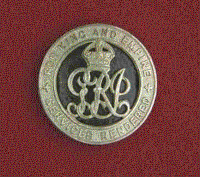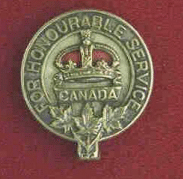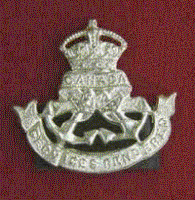Service Medals:
The Canadian and British governments awarded medals to soldiers in recognition of their service during the First World War, based on the date and location of service. The following service medals and badges were awarded to members of the Canadian Expeditionary Force, 1914 - 1919:
a) 1914 Star:
The 1914 Star was awarded to "all officers, non-commissioned officers and men of the British and Indian Expeditionary Forces, (including civilian medical practitioners, nursing sisters, nurses and others who were employed with military hospitals), serving in France or Belgium on the establishment of the British Expeditionary Forces between 05 August 1914 and midnight of 22/23 November 1914". The medal is sometimes referred to as the "Mons Star".
 |
| 1914 Star (Veterans Affairs Canada War Medals) |
Only a handful of Canadians attached to British units and 160 members of the 2nd Canadian Stationary Hospital serving in the British Expeditionary Force as of November 6, 1914 qualified for this award, making it the rarest of medals awarded to Canadian soldiers and military personnel during the First World War.
b) 1914-15 Star:
This medal recognized the contributions of the war's earliest military recruits. In terms of Canadians, it was awarded mainly to military personnel who served overseas with the 1st and 2nd Canadian Divisions created in 1914 and 1915 respectively. The 1914-15 Star was awarded to "all who saw service in any theatre of war against the Central Powers between 05 August 1914 and 31 December 1915 except those eligible for the 1914 Star". As the term "overseas" applied to military personnel who served beyond the three-mile limit, individuals serving on many small Royal Canadian Navy vessels qualified for this award.
 |
| James Alexander Fogarty's 1914-15 Star |
Authorized in December 1918, a total of 71,150 Canadians received the 1914-15 Star. The medal was always issued in conjunction with the British War Medal and Victory Medal, both of which are described below.
c) British War Medal:
 |
| British War Medal of Pte. James Leo McDonald (obverse on left, reverse on right) |
 |
| British War Medal (obverse) of Pte. Robert Burns, Salmon River Lake |
 |
| British War Medal (reverse) of Pte. James Leo McDonald, Auld's Cove |
d) Victory Medal:
The second of the most common World War I service medals, the Victory Medal was awarded to "all ranks of the fighting forces, to civilians under contract, and others employed with military hospitals who actually served in the establishment of a unit in a theatre of war between 05 August 1914 and 11 November 1918 (inclusive)". Intended to commemorate the Allied victory over the Central Powers, the medal was issued by all countries who were part of the victorious Allied war effort and is sometimes referred to as the "Inter-Allied War Medal". All Allied Victory Medals had the same obverse design, while the reverse side was unique to each Allied country.
 |
| Victory Medal (obverse) of Pte. James Leo McDonald, Auld's Cove |
 |
| Victory Medal (reverse) of Pte. James Leo McDonald, Auld's Cove |
Established in Canada by outgoing Canadian Governor-General, the Duke of Connaught, on August 16, 1916, War Service Badges were originally intended to recognize the contribution of individuals who qualified in one of three categories:
a) men who were honorably discharged from the Canadian Expeditionary Force, usually due to poor health or physical injury;
b) men who offered themselves for active service but were rejected for health/medical reasons;
c) men who desired to or had offered to enlist but were refused because their services in their present employment were deemed "more valuable" to the war effort.
In February 1917, a fourth class was added and the three initial categories were redefined as follows:
1. Army Class A service badges were awarded to men who served at the Front and had retired, relinquished their commission, been honouably discharged or returned to Canada on military duty.
 |
| Army Class A Service Badge of Pte. James Leo McDonald, Auld's Cove |
 |
| Army Class B Service Badge (Veterans Affairs Canada War Service Badges) |
 |
| Army Class C Service Badge (Veterans Affairs Canada War Service Badges) |
 |
| Navy Class AA Service Badge (Veterans Affairs Canada War Service Badges) |
Memorial Medals:
Memorial medals were awarded to the next of kin of Canadian soldiers who were killed in the line of duty during the First World War or who subsequently died of wounds inflicted in combat. Two distinct awards fall into this category: the Memorial Cross and the Memorial Plaque and Scroll.
a) Memorial Cross:
The Memorial Cross was awarded by the Canadian government to "mothers and widows (next of kin) of Canadian soldiers who died on active duty or whose death was consequently attributed to such duty." Created by Order-in-Council on December 1, 1919, it is also referred to as the "Silver Cross". This medal was sent to mothers and wives whose sons/husbands met the stated guidelines. The deceased's name and service number were engraved on the back of each medal. Recipients were entitled to wear the medal at any time.
 |
| Memorial Cross of Pte. Clayton Mills, Glenelg |
Awarded by the British government to all qualified soldiers in British and Imperial forces, this plaque was sent to the next of kin of all individuals who lost their lives while in active service during the First World War. The 120 mm. bronze obverse bears the inscription, " He (or she) died for freedom and honour", with the name of the deceased engraved in a small, rectangular space.
 |
| Memorial Plaque of Pte. Clayton Mills, Glenelg |
The Memorial Scroll accompanied each Memorial Plaque. It consisted of a certificate displaying the emblem of King George V followed by a text passage in honor of the deceased individual, whose name and unit were printed at the bottom of the document.
 |
| Memorial Scroll |
*****
Sources:
Canadian Military Medals and Decorations. Veterans Affairs Canada.
First World War Medals. Stephen's Study Room.
Pte. Robert Burns' British War Medal courtesy of nephew Rod MacDonald, Salmon River Lake, NS.
Pte. James Leo McDonald's war medals and badge courtesy of son Ralph MacDonald, Thorburn, NS.
Pictures of Pte. Clayton Mill's Memorial Cross and Plaque courtesy of John Selwyn Mills, Riverview, NB.
Photography of Pte. James Leo McDonald's medals courtesy of Bonnie McGrath, St. Andrews, NS.
Canadian Military Medals and Decorations. Veterans Affairs Canada.
First World War Medals. Stephen's Study Room.
Pte. Robert Burns' British War Medal courtesy of nephew Rod MacDonald, Salmon River Lake, NS.
Pte. James Leo McDonald's war medals and badge courtesy of son Ralph MacDonald, Thorburn, NS.
Pictures of Pte. Clayton Mill's Memorial Cross and Plaque courtesy of John Selwyn Mills, Riverview, NB.
Photography of Pte. James Leo McDonald's medals courtesy of Bonnie McGrath, St. Andrews, NS.

Great overview! Thank you for writing this.
ReplyDeleteYou're most welcome, Eric! When I first started researching First World War soldiers, it took some time to sort out all of the various medals and decorations. I thought this would be helpful information for others doing similar work.
Delete